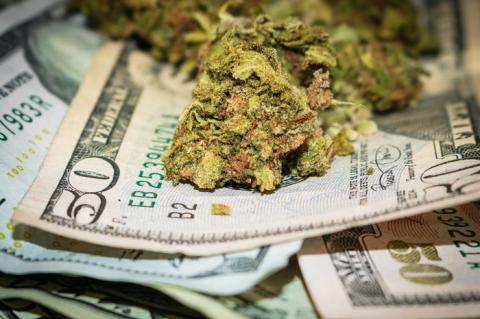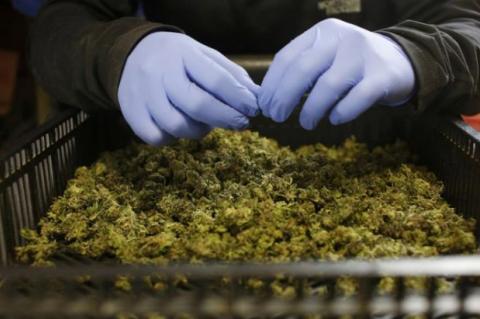Did you know that the roots of today's cannabis culture can be traced back to the African continent from hundreds of years ago? According to Dr. Chris Duvall, author of The African Roots of Marijuana, the forgotten history of global cannabis culture continues to have contemporary influence, writes Timothy Harris.
“Africa is ignored in the collective historical narrative," Duvall writes. "More important, the nonportrayal of Africa intellectually justifies notions that drug use is a racially determined behavior. The collective narrative, being unconstrained by evidence of the plant’s African past, enables anti-Black, racial stereotypes about cannabis drug use. In the United States, one outcome of these stereotypes is biased drug-law enforcement.”
In his book, Duvall investigates questions of where cannabis came from, and who first smoked it. We learn that no, contrary to stereotype, neither Rastafarians nor hippies had anything to do with the origins of cannabis use or cultivation. In fact, if you look back far enough into history, you'll learn that cannabis arrived in Africa about 1,000 years ago, by way of south Asia.
But before we dig into the African roots of cannabis culture, let's identify our terminology. In the scientific community, there are two genetic groupings of cannabis plants: Cannabis indica and Cannabis sativa. This distinction is actually where we get the terms for the effects of your favorite strains, though the taxonomic names have nothing to do with that. Scientists use the name Cannabis indica for plant groupings that have psychoactive qualities and Cannabis sativa — sometimes just called “hemp” — for those that do not. When your budtender says a particular strain is “indica” or “sativa,” they are referencing the “folk meaning” of those terms, not the formal names of these genetic groupings of cannabis plants.
This article is focused on Cannabis indica, meaning psychoactive cannabis, more broadly (as opposed to a strain that might make you extra sleepy).
From an evolutionary standpoint, Cannabis indica originated around the Hindu Kush mountains (yes, the Kush Mountains) in southern Asia. Around 4,000 years ago, people in this region processed cannabis in two ways: for resin, called charas, and for the flowers. Indeed the original Hindi word for cannabis flower, dating back at least 3,000 years, was “ganja.” Sound familiar?
At this point in history, the production of ganja in southern Asia is some of the most compelling early evidence of harvesting cannabis buds in particular, although they were mostly consumed in the form of edibles, like bhang, a smoothie-like concoction popular in India and in Hindu mythology.
Dr. Duvall studies historical names for cannabis to trace the movement of the plant, and found that it entered Africa from the east.
This is where it gets good. Cannabis edible culture developed into a smoking culture.
“People discovered that their preexisting technologies of smoking transformed the plant drug, changing it from a slow-acting edible drug into a fast-acting, easily-dosed pharmacological agent,” Duvall writes.
Once in Africa, different names for cannabis started to show up regionally. One such name that is still used today is “hashish.” This word came into use in Egypt by 1200 and colloquially translated to “the herb.”
As cannabis spread to western Africa, the names for cannabis changed, and one very important term for modern cannabis appeared in historical literature.
The existing documentary records that researchers work from were primarily written by European colonizers who weren’t very interested in understanding African culture or Bantu languages.
For example, an Englishwoman in Sierra Leone circa 1847 wrote about cannabis (not yet realizing it was a distinctive plant) as a “tobacco of poisonous-smelling qualities.” This wasn't out of the ordinary, however, as Europeans mis-reported many of the African words for cannabis as “tobacco" quite frequently "probably because they did not know or care what Africans were smoking," Dr. Duvall writes. "Europeans widely called cannabis 'African tobacco,' 'Angolan tobacco,' and 'Congo tobacco' to distance their own smoking practices from African ones." (Regarding the term “Congo,” it’s important to recognize that slavers created this word as a catch-all to describe various ethnic groups of West Africa. Prior to slavery, “Congo” did not designate any cultural, linguistic or ethnic group.)
Beyond Europeans' inaccurate records regarding cannabis use among Africans at the time, there is added obscurity in the historical record because of the long-standing stigma associated with cannabis use. There are at least two recorded instances, particularly by “Afro-Brazillians,” using the Portugese words “tabaco,” meaning tobacco, and “fumo,” meaning smoke, in order to intentionally disguise their cannabis use. (In a sense, asking if someone “smokes” is, and has been, a universally understood way for cannabis users to discreetly recognize each other.)
Despite, however, the poor record-keeping and intentional ambiguity, Dr. Duvall has pieced together enough evidence from what Europeans wrote to show that people in west Africa referred to cannabis as either riamba, liamba, diamba or iamba — pronounced “jamba.” The prefix ma- was added to words to show pluralism, just like how in English we add an -s to indicate multiples.
“The plural marker ma- was used historically to mean ‘some,’ so ma-riamba would be ‘some cannabis to smoke,’” Dr. Duvall tells Civilized.
Hence, “mariamba” is where the word “marijuana” comes from. The word “marijuana” as we know it today didn’t appear until 1846 in Farmacopea Mexicana, though it was spelled “mariguana.” In most following instances, the word was spelled marihuana.
This word cognate group riamba, liamba, diamba and iamba appeared in writing in Brazil by 1839. But how exactly did a Bantu word cross the Atlantic Ocean from Africa to the Americas? Around this time, millions of Africans were captured as slaves and taken across the ocean. Captive Africans are responsible for bringing centuries-old cannabis culture and knowledge to the Americas. But, it wasn’t a direct path to the United States.
You might be wondering if slaves taken directly to the modern day U.S. brought cannabis knowledge with them. Perhaps. But of the 10.7 million slaves known to have survived the trans-atlantic voyage, fewer than 400,000 (or less than four percent) were taken directly to North America.
So now you might assume that migrants from South and Central America to the U.S. are responsible for bringing cannabis to the States. However, that's not the case, either. But what these migrants did bring is the knowledge of cannabis as a smoked drug.

There is archaeological evidence of Africans using water pipes made from clay or large gourds as early as 1600, specifically for smoking cannabis. More simplistic than that, even, the basic understanding of cannabis anatomy and the chemical properties of the flowers is owed to Africans hundreds of years back. Bongs, buds, pipes and even the words we use to talk about cannabis have clear roots outside of the U.S.. Modern cannabis culture is a direct result of the staunch transmission of tradition through generations. Cannabis is global, it doesn’t belong to anyone, and it’s important we start treating everyone equally, considering that notion.
Cannabis was already present in the United States. The plant arrived via European settlers who had traded with Asia and Africa and was most often meant to be used as a medicine. But, the trading of cannabis plants between continents often excluded the trading of cannabis knowledge, thus most cannabis-based products at the time were prepared improperly and were virtually useless and certainly non-psychoactive. An 1862 issue of Vanity Fair contains an ad for “hasheesh candy” to cure nervousness, weakness, melancholy and confusion of thoughts.
“For the most part, people in Europe and North America had no knowledge or understanding of getting high from cannabis," says Duvall. "And so marijuana, that term, but also the use of the plant as a smoked drug, shows up early in the 1900’s in the United States.”
Migrants, brought to the United States as laborers, also brought with them cannabis smoking culture.
“Cannabis literature has built up this ‘race’ and ‘racial’ narrative but it neglects the role of ‘class,'" Duvall says. "Historically, the people who used and relied upon cannabis were the people who were ‘down and out,’ people who were in marginalized social classes...those are the people who really found value in cannabis.”
A 2013 federal survey revealed that this trend is still apparent today — those in lower social classes tend to use cannabis at a higher rate. Cannabis has always been used by those most needing therapeutic relief, both physically and mentally.
African cannabis culture and knowledge arrived to the U.S. via migrant workers from South and Central America, as well as via sailors from Africa in the late 1800s. The arrival of cannabis to the U.S. via black and brown folks is undoubtedly, part of the basis of historically racist drug law enforcement. In fact, Dr. Duvall says that the “j” in the word “marijauna” arose from “American English discourse that tagged the plant drug Juana to strengthen portrayals of its unsavory Mexicanness in the early 1900s.”
Popularly, Harry Anslinger, the first commissioner of the U.S. Federal Bureau of Narcotics, is portrayed as a mastermind behind the plan to target minorities by criminalizing cannabis use. However, truthfully, Anslinger was mostly concerned about opiates.
It is true that Anslinger was largely responsible for cannabis prohibition policy-wise. The U.S. formally outlawed cannabis with the Marijuana Tax Act of 1937, but several other nations, including Mexico (1920), Greece (1890), and South Africa (1870), had already banned cannabis use. The U.S. was not the first to adopt totalitarian cannabis laws. In 1877, the sultan of Turkey even ordered that all cannabis be confiscated and destroyed across the nation.
Global controls on cannabis began in 1925, when the League of Nations, the precursor to the United Nations, held its second conference on international drug control. A handful of African nations sought to add cannabis to the breadth of global drug control.
“They had their various reasons for doing that, but that move is what made it so that Anslinger really had ground to say, ‘Let's consider cannabis more broadly than just these state and local ordinances that exist in the U.S. at the time. This is a global issue.’ That’s what really made it so that he could include cannabis in U.S. drug laws,” Dr. Duvall said.
Beyond global discussion of cannabis, Anslinger was able to outlaw cannabis use because it was commonly associated with two highly vulnerable populations: Black jazz musicians and Mexican immigrants. The problem with racism and cannabis in the U.S. is systemic. It is, and always was, bigger than just one person.
“United States law enforcement has been racist since it was founded. Drug-law enforcement has been racist since it was founded,” said Dr. Duvall.
What is the cause of the misinformation? Most of the literature available covers the 1960s-70s, Anslinger and the U.S. exclusively, ignoring the rest of global history.
“We often lose perspective of how cannabis existed around the world,” Dr. Duvall said.
Nearly 100 years after the beginnings of global cannabis control, the world is finally seeing a shift. In the United States, 11 states and Washington DC have legalized cannabis for adult use, and 33 states allow for medicinal use. In Mexico, Greece and South Africa — some of the first nations to outlaw cannabis — the laws are changing, too. Greece and South Africa both allow for some cannabis use. Mexico is currently in the midst of nationwide drug law reform which will likely include cannabis decriminalization at some level. Perhaps through globalization, the same process that brought the spread of prohibition, a wave of legalization will supercede these antiquated paradigms.




